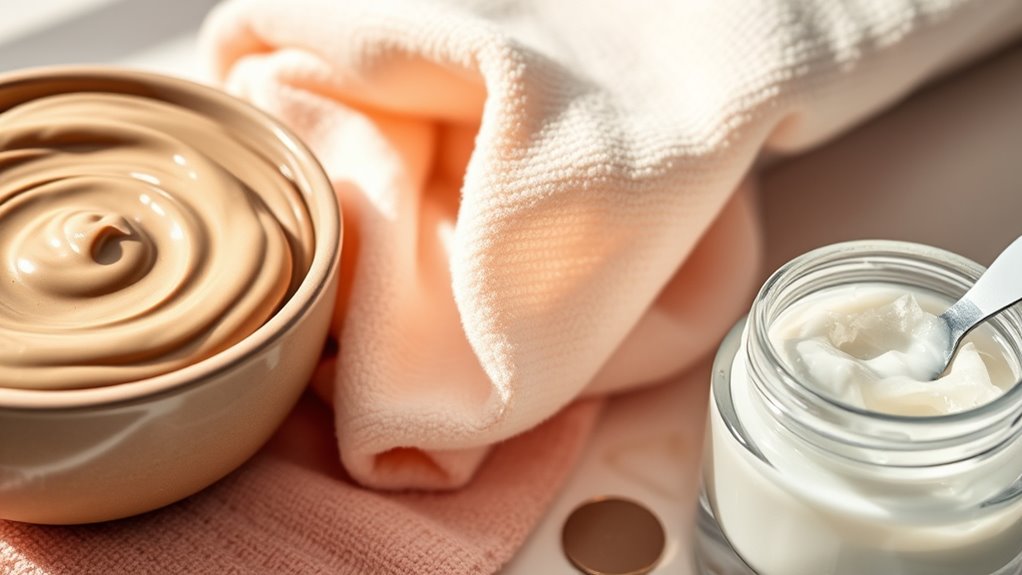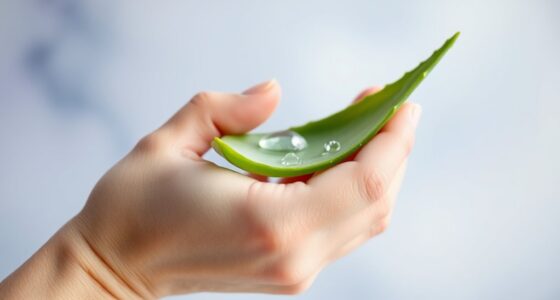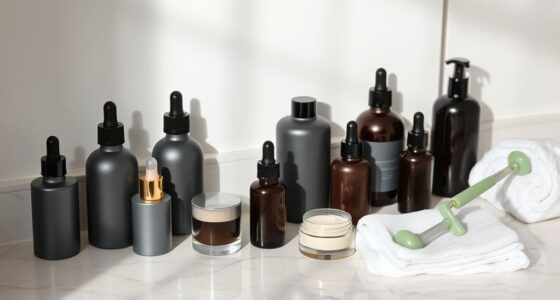Choosing the right face mask depends on your skin type and goals. If you have oily or acne-prone skin, a clay mask can help detoxify and control oil. For deep hydration and nutrient boost, sheet masks are ideal. If you want to tighten pores and remove impurities, peel-off masks work well. Each type offers unique benefits, and exploring them further can help you find the best fit for your skincare routine.
Key Takeaways
- Clay masks are best for oily, acne-prone skin to detoxify and control shine.
- Sheet masks provide quick, intense hydration and nutrients, ideal for dry or dull skin.
- Peel-off masks help remove impurities and dead skin, suitable for pore cleansing and skin refreshment.
- Choose based on your skin type: oil control (clay), hydration (sheet), or deep cleansing (peel-off).
- Proper application and ingredient awareness maximize mask benefits and suit your skincare goals.

Have you ever wondered why face masks have become a common sight in daily life? It’s because they offer a quick and effective way to boost your skin’s health and appearance. Whether you’re targeting oiliness, dryness, or dullness, choosing the right mask can make a noticeable difference. But with so many options—clay, sheet, peel-off—it can be overwhelming to pick the best one. Let’s focus on understanding the ingredients overview and application techniques for each type to help you decide what suits your skin best.
Starting with clay masks, these are known for their deep-cleansing properties. The ingredients overview typically includes clays like bentonite or kaolin, which absorb excess oil and impurities from your pores. They often contain additional ingredients like charcoal or tea tree oil for added detoxifying effects. These masks are ideal if you have oily or acne-prone skin because they help control shine and reduce breakouts. When applying a clay mask, you want to start with clean, dry skin. Use a brush or your fingertips to spread an even layer over your face, avoiding the delicate eye area. Allow it to dry for about 10-15 minutes—no longer, to prevent over-drying—and then rinse thoroughly with lukewarm water. Pat dry and follow up with a moisturizer. Proper application techniques guarantee you get the maximum benefit without irritation. Regular use can also promote a refined skin texture, making your pores less visible.
Sheet masks, on the other hand, are soaked in a serum-rich essence and come in pre-cut fabric or hydrogel sheets. The ingredients overview includes hydrating agents like hyaluronic acid, aloe vera, or vitamins C and E, depending on the formula. They’re designed to deliver concentrated nutrients directly to your skin in a quick, convenient way. To use a sheet mask effectively, start with a clean face. Unfold the mask carefully and place it over your face, aligning it with your eyes, nose, and mouth. Smooth out any air bubbles with your fingers to ensure full contact. Leave it on for about 15-20 minutes—no longer, as the serum may start to dry out and draw moisture back from your skin. After removing the mask, gently massage any remaining serum into your skin or pat it in. This technique maximizes absorption and hydration.
Peel-off masks are a bit more hands-on. Their ingredients often include ingredients like charcoal, clay, or fruit extracts to tighten pores and remove impurities. The application technique involves spreading a thin, even layer over cleansed skin, avoiding the eye area. Let it dry completely, usually around 15-20 minutes, until it feels firm. Then, gently peel the mask off in one piece, starting from the edges. This method pulls out dirt, dead skin, and excess oils, leaving your skin feeling refreshed. After peeling, rinse your face to remove any residue and follow with moisturizer. The key to a good peel-off application is a thin, even layer and patience in letting it dry fully for easy removal. Using glycolic acid at appropriate concentrations can also enhance exfoliation and improve overall skin appearance, especially when incorporated into your routine gradually.
Understanding these ingredients and application techniques helps you choose the right mask for your skin type and needs, making your skincare routine more effective and enjoyable.
Frequently Asked Questions
Can Face Masks Cause Allergic Reactions?
You might wonder if face masks can cause allergic reactions. Yes, they can, especially if you have sensitive skin or allergy symptoms. Always check ingredient safety before trying a new mask, as certain ingredients like fragrances or preservatives may trigger reactions. To stay safe, do a patch test first. If you notice redness, itching, or swelling, stop use immediately and consult a dermatologist to avoid worsening allergy symptoms.
How Often Should I Use Each Type of Mask?
Ever wonder how often you should indulge in face masks? Think of your skin as a garden that needs just the right watering. For clay masks, apply once a week to control oil; sheet masks can be used 2-3 times weekly for hydration. Peel-off masks, depending on skin sensitivity, should be limited to once a week. Always consider your skin type and adjust your application frequency accordingly for healthy, glowing skin.
Are There Masks Suitable for Sensitive Skin?
If you have sensitive skin, you should look for masks with gentle ingredients like aloe vera, chamomile, or oatmeal. Always do an allergy test before trying a new mask to avoid irritation. Stick to formulas labeled for sensitive skin, and avoid harsh chemicals or fragrances. This way, you can enjoy the benefits of a mask without compromising your skin’s comfort or causing reactions.
Can I Wear Masks Overnight?
Think of overnight masks as a nightly dose of nourishment, like a slow-release vitamin for your skin. While the benefits of overnight masks include deep hydration and repair, sleeping masks can also pose risks, such as clogged pores or irritation if not suitable for your skin type. If you have sensitive skin, it’s best to consult a dermatologist before trying an overnight mask, to avoid potential adverse effects.
Do Face Masks Replace Proper Skincare Routines?
You might wonder if face masks can replace your skincare routine, but they shouldn’t. Masks can boost your routine’s efficacy, targeting specific concerns, but they’re not a substitute for daily cleansing, moisturizing, and sun protection. Instead, think of masks as an occasional enhancement that integrates into your routine. Proper skincare involves consistent, all-encompassing steps, with masks playing a supportive role to help you achieve healthier, clearer skin.
Conclusion
Choosing the right face mask is like finding a trusted friend who understands your skin’s needs. Whether you opt for clay, sheet, or peel-off, each has its unique charm and purpose. Think of it as a personal spa day, where you’re the artist and your skin is the canvas. Trust your instincts, experiment a little, and soon you’ll discover the perfect mask that makes your skin glow like a sunrise after a storm.









